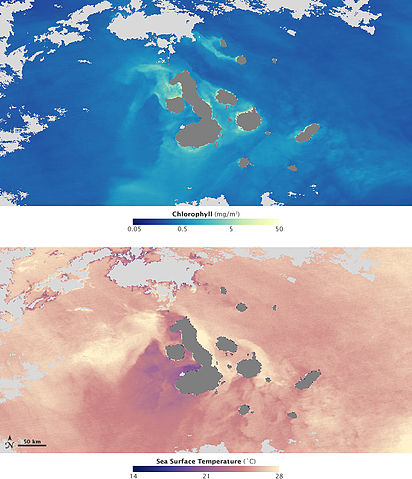 |
This is a file from the Wikimedia Commons. Information from its description page there is shown below.
Commons is a freely licensed media file repository. You can help.
|
Summary
| Description |
Sea surface temperature & chlorophyll concentrations off the Galapagos archipelago.jpg
English: The Cromwell Current stirs up the ocean on the west (leeward) side of the Galapagos, and brings cool, nutrient-rich water up from the ocean depths. The nutrients nourish phytoplankton, which form the base of the ocean’s food web. Many fish, birds, and marine mammals depend on the phytoplankton. The bottom image shows sea surface temperature, cool up welling waters are coloured purple. Thriving phytoplankton populations are indicated by high chlorophyll concentrations (top image), coloured green and yellow. Images acquired on March 2, 2009.
|
| Date |
18 July 2009 |
| Source |
NASA Earth Observatory |
| Author |
Robert Simmon and Jesse Allen |
Images acquired by NASA’s Moderate Resolution Imaging Spectroradiometer (MODIS) aboard the Aqua satellite.
Licensing
| Public domainPublic domainfalsefalse |
 |
This file is in the public domain because it was solely created by NASA. NASA copyright policy states that "NASA material is not protected by copyright unless noted". (See Template:PD-USGov, NASA copyright policy page or JPL Image Use Policy.) |
|
|
|
Warnings:
- Use of NASA logos, insignia and emblems are restricted per US law 14 CFR 1221.
- The NASA website hosts a large number of images from the Soviet/ Russian space agency, and other non-American space agencies. These are not necessarily in the public domain.
- Materials based on Hubble Space Telescope data may be copyrighted if they are not explicitly produced by the STScI. See also {{ PD-Hubble}} and {{ Cc-Hubble}}.
- The SOHO (ESA & NASA) joint project implies that all materials created by its probe are copyrighted and require permission for commercial non-educational use.
- Images featured on the Astronomy Picture of the Day (APOD) web site may be copyrighted.
|
File usage
The following pages on Schools Wikipedia link to this image (list may be incomplete):
SOS Childrens Villages chose the best bits of Wikipedia to help you learn. SOS Children's Villages helps more than 2 million people across 133 countries around the world. If you'd like to help, why not learn how to sponsor a child?





